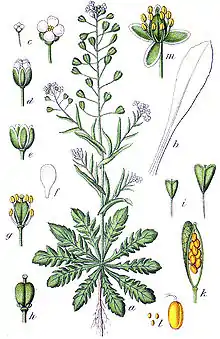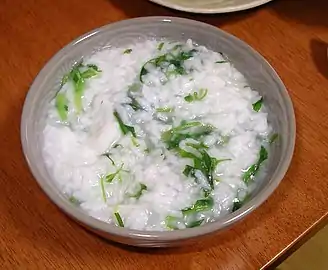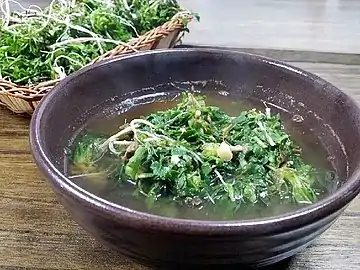Capsella bursa-pastoris
Capsella bursa-pastoris, known as shepherd's purse because of its triangular flat fruits, which are purse-like, is a small annual and ruderal flowering plant in the mustard family (Brassicaceae).[2] It is native to eastern Europe and Asia minor,[3] but is naturalized and considered a common weed in many parts of the world, especially in colder climates,[4] including British Isles,[5] where it is regarded as an archaeophyte,[6][7] North America[8][9] and China,[10] but also in the Mediterranean and North Africa.[3] C. bursa-pastoris is the second-most prolific wild plant in the world,[10] and is common on cultivated ground and waysides and meadows.[11]
| Shepherd's purse | |
|---|---|
 | |
| Flowering and fruiting | |
| Scientific classification | |
| Kingdom: | Plantae |
| Clade: | Tracheophytes |
| Clade: | Angiosperms |
| Clade: | Eudicots |
| Clade: | Rosids |
| Order: | Brassicales |
| Family: | Brassicaceae |
| Genus: | Capsella |
| Species: | C. bursa-pastoris |
| Binomial name | |
| Capsella bursa-pastoris | |
| Synonyms[1] | |
|
List
| |
Scientists have referred to this species as a 'protocarnivore', since it has been found that its seeds attract and kill nematodes as a means to locally enrich the soil.[12][13]
Description

Capsella bursa-pastoris plants grow from a rosette of lobed leaves at the base. From the base emerges a stem about 0.2–0.5 m (0.66–1.64 ft) tall, which bears a few pointed leaves which partly grasp the stem. The flowers, which appear in any month of the year in the British Isles,[11]:56 are white and small, 2.5 mm (0.098 in) in diameter, with four petals and six stamens.[11] They are borne in loose racemes, and produce flattened, two-chambered seed pods known as siliques, which are triangular to heart-shaped, each containing several seeds.[9]
Like a number of other plants in several plant families, its seeds contain a substance known as mucilage, a condition known as myxospermy.[14] Recently, this has been demonstrated experimentally to perform the function of trapping nematodes, as a form of 'protocarnivory'[12][13][15]
Capsella bursa-pastoris is closely related to the model organism such as Arabidopsis thaliana and is also used as a model organism, due to the variety of genes expressed throughout its life cycle that can be compared to genes that are well studied in A. thaliana. Unlike most flowering plants, it flowers almost all year round.[9][10] Like other annual ruderals exploiting disturbed ground, C. bursa-pastoris reproduces entirely from seed, has a long soil seed bank,[6] and short generation time,[3] and is capable of producing several generations each year.
Taxonomy
It was formally described by the Swedish botanist Carl Linnaeus in his seminal publication Species Plantarum in 1753, and then published by Friedrich Kasimir Medikus in Pflanzen-Gattungen (Pfl.-Gatt.) on page 85 in 1792.[16][17]
Capsella bursa-pastoris subsp. thracicus (Velen.) Stoj. & Stef. is the only known subspecies.[16]
William Coles wrote in his book, Adam in Eden (1657), "It is called Shepherd's purse or Scrip (wallet) from the likeness of the seed hath with that kind of leathearne bag, wherein Shepherds carry their Victualls [food and drink] into the field."[18]
In England and Scotland, it was once commonly called 'mother's heart', which is derived from a child's game/trick of picking the seed pod, which then would burst and the child would be accused of 'breaking his mother's heart'.[18]
Uses
Capsella bursa-pastoris gathered from the wild or cultivated[19][20] has many uses, including for food,[10][20] to supplement animal feed,[19] for cosmetics,[19] and in traditional medicine[10][19]—reportedly to stop bleeding.[21] It can be eaten raw in salad.[22] Native Americans ground it into a meal and made a beverage from it.[21]
Cooking
It is cultivated as a commercial food crop in Asia.[23] In China, where it is known as jìcài (荠菜; 薺菜) it is commonly used in food in Shanghai and the surrounding Jiangnan region. It is stir-fried with rice cakes and other ingredients or as part of the filling in wontons.[24] It is one of the ingredients of the symbolic dish consumed in the Japanese spring-time festival, Nanakusa-no-sekku. In Korea, it is known as naengi (냉이) and used as a root vegetable in the characteristic Korean dish, namul (fresh greens and wild vegetables).[25]
Shepherd's purse was used as a pepper substitute in colonial New England.[26]
 Nanakusa-gayu (seven herb congee)
Nanakusa-gayu (seven herb congee) Naengi-doenjang-guk (soybean paste soup with shepherd's purse)
Naengi-doenjang-guk (soybean paste soup with shepherd's purse)
Chemistry
Fumaric acid is one chemical substance that has been isolated from C. bursa-pastoris.[27]
Parasites
Parasites of this plant include:
- White rust Albugo candida
- One species of downy mildew Hyaloperonospora parasitica
References
- [powo.science.kew.org/taxon/urn:lsid:ipni.org:names:30092589-2#synonyms "Capsella bursa-pastoris (L.) Medik"] Check
|url=value (help). Plants of the World Online. Board of Trustees of the Royal Botanic Gardens, Kew. 2017. Retrieved 2 August 2020. - Parnell, J. Curtis, T. (2012). Webb's An Irish Flora. Cork University Press. p. 262. ISBN 978-185918-4783.CS1 maint: multiple names: authors list (link)
- Aksoy, A; Dixon, JM; Hale, WH (1998). "Biological flora of the British Isles. Capsella bursa-pastoris (L.) Medikus (Thlaspi bursapastoris L., Bursa bursa-pastoris (L.) Shull, Bursa pastoris (L.) Weber)". Journal of Ecology. 86: 171–186. arXiv:1303.1393. doi:10.1046/j.1365-2745.1998.00260.x.
- "Capsella bursa-pastoris". Flora of Pakistan.
- Clapham, A.R., Tutin, T.G. and Warburg, E.F. 1968. Excursion Flora of the British Isles. Cambridge University Press. ISBN 0-521-04656-4
- Preston CD, Pearman DA & Dines TD (2002) New Atlas of the British Flora. Oxford University Press
- Preston, CD; Pearman, DA; Hall, AR (2004). "Archaeophytes in Britain". Botanical Journal of the Linnean Society. 145 (3): 257–294. doi:10.1111/j.1095-8339.2004.00284.x.
- USDA PLANTS Profile: Capsella bursa-pastoris (L.) Medik
- Blanchan, Neltje (2005). Wild Flowers Worth Knowing. Project Gutenberg Literary Archive Foundation.
- "Capsella bursa-pastoris". Flora of China.
- Clapham, A.R.; Tutin, T.G.; Warburg, E.F. (1981). Excursion Flora of the British Isles (Third ed.). Cambridge University Press. ISBN 978-0521232906.
- Nature - Evidence for Facultative Protocarnivory in Capsella bursa-pastoris seeds
- Telegraph - Tomatoes Can Eat Insects
- Tamara L. Western; Debra J. Skinner; George W. Haughn (February 2000). "Differentiation of Mucilage Secretory Cells of the Arabidopsis Seed Coat". Plant Physiology. 122 (2): 345–355. doi:10.1104/pp.122.2.345. PMC 58872. PMID 10677428.
- Barber, J.T. (1978). "Capsella bursa-pastoris seeds: Are they "carnivorous"?" (PDF). Carnivorous Plant Newsletter. 7 (2): 39–42.
- "Capsella bursa-pastoris (L.) Medik. is an accepted name". theplantlist.org. 23 March 2012. Retrieved 14 December 2017.
- "Brassicaceae Capsella bursa-pastoris Medik". ipni.org. Retrieved 14 December 2017.
- Reader's Digest Field Guide to the Wild Flowers of Britain. Reader's Digest. 1981. p. 54. ISBN 9780276002175.
- "Capsella bursa-pastoris (Ecocrop code 4164)". ecocrop. Food and Agriculture Organization of the United Nations. Archived from the original on 2016-03-04. Retrieved 2008-08-06.
- "Capsella bursa-pastoris - (L.)Medik". Plants For A Future database report.
- Nyerges, Christopher (2017). Foraging Washington: Finding, Identifying, and Preparing Edible Wild Foods. Guilford, CT: Falcon Guides. ISBN 978-1-4930-2534-3. OCLC 965922681.
- Nyerges, Christopher (2016). Foraging Wild Edible Plants of North America: More than 150 Delicious Recipes Using Nature's Edibles. Rowman & Littlefield. p. 164. ISBN 978-1-4930-1499-6.
- Mills, David (March 11, 2014). Nature's Restaurant: Fields, Forests & Wetlands Foods of Eastern North America - A Complete Wild Food Guide.
- Samuels, Debra (12 May 2015). "This Chinese grandma forages and cooks". bostonglobe.com. Retrieved 14 December 2017.
- Pratt, Keith L.; Richard Rutt; James Hoare (1999). Korea: a historical and cultural dictionary. Richmond, Surrey.: Curzon Press. p. 310. ISBN 978-0-7007-0464-4.
- Hussey, Jane Strickland (Jul–Sep 1974). "Some Useful Plants of Early New England". Economic Botnany. 28 (3): 311–337. doi:10.1007/BF02861428. JSTOR 4253521. S2CID 12764441.
- Kuroda, K.; Akao, M.; Kanisawa, M.; Miyaki, K. (1976). "Inhibitory effect of Capsella bursa-pastoris extract on growth of Ehrlich solid tumor in mice". Cancer Research. 36 (6): 1900–1903. PMID 1268843.
External links
- Mrs. M. Grieve. A Modern Herbal. Shepherd's Purse
 Media related to Capsella bursa-pastoris at Wikimedia Commons
Media related to Capsella bursa-pastoris at Wikimedia Commons